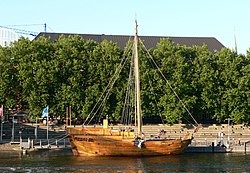利用者:安息香酸/砂場7
 |
ここは安息香酸さんの利用者サンドボックスです。編集を試したり下書きを置いておいたりするための場所であり、百科事典の記事ではありません。ただし、公開の場ですので、許諾されていない文章の転載はご遠慮ください。
登録利用者は自分用の利用者サンドボックスを作成できます(サンドボックスを作成する、解説)。 その他のサンドボックス: 共用サンドボックス | モジュールサンドボックス 記事がある程度できあがったら、編集方針を確認して、新規ページを作成しましょう。 |
en:Horse transports in the Middle Agesのoldid=1227058417版を翻訳。

中世において、船舶は長距離にわたる馬の輸送手段として、戦役の際も交易の際も用いられた。これらの船舶は中世初期のケルト文化圏・ゲルマン文化圏・地中海文化圏で広く見られた。
軍役における輸送
[編集]地中海世界
[編集]
ローマ帝国は馬の効率的な輸送方法を作り上げ、中世初期にはアラブ人がその方法に更なる改良を加えた。そしてこの方法は10世紀ごろにはヨーロッパで普遍的な輸送方法として広まった[1]。これらの輸送船は櫂または風力で推進力を得るタイプの船であった。
taridaと呼ばれる軍輸送船は扉を傾斜路として活用することで浜辺に直接積み荷を積み下ろしすることができた[2]。1174年にイタリア系ノルマン人がアレクサンドリアに侵攻した際、36隻のtarida船で1500騎の騎馬を輸送したという[3]。現存している13世紀の詳細なtarida船構造図によれば、一隻当たり20⁻30騎の馬を輸送できたとされる。アンジュースタイルのtarida船は、馬は3頭ずつキャンバスの吊り具で支える構造をしていた。1246年のジェノバスタイルのtarida船は150もの水桶を搭載しており、これは合計39.750Lもの量に達していたという[4]。
他の種類の輸送手段として、usciere(イタリア語)・huissiers(フランス語)・usserii(ラテン語)として各地で知られている別形式の船舶が挙げられる。この形式の船舶は2層甲板を持ち一度に100頭ほどの馬を輸送できたとされる。この形式の船舶は船体に開けられた出入り口から馬を搬入出し、航海中は搬入出口は密閉されていた。フランス王ルイ9世に向けてヴェネチア共和国が1268年に建造したusciere船は、全長25.76m・船幅6.1mで、2層甲板を有し2本のマストを備えていたという[5]。
北ヨーロッパ
[編集]
Records of cavalry transportation abound throughout the period, reflecting the changes in warfare. For example, the Scandinavians had adapted the horse-transport technology by the 12th century as part of their move away from the traditional Viking infantry.[6] The first illustration displaying such horse-transport in western Europe can be found in the Bayeux Tapestry's depiction of the Norman conquest of England.[7] This particular military venture required the transfer of over 2,000 horses from Normandy.[8] Scholars have linked the successful use of horse transports during the Norman conquest of England to Norman interactions with Byzantines (who had mastered horse transportation in amphibious operations) in Southern Italy in the 11th century.[9][10]
The small size of many transport vessels available and the need to carry fodder and water on all but the shortest journeys restricted the number of horses that could be carried. Records from the 13th century show a range from 8 to 20 horses.[11] In 1303 ships transporting horses between Scotland and Ireland carried between 10 and 32 animals.[12]
Adapting a ship for horse transportation required the installation of stalls of wood or hurdles. Detailed records of the fitting of an English fleet of 1340 show the creation of 418 hurdles, 413 iron rings and staples, canvas mangers and the creation of four gangways for loading 30 feet long by 5 wide. Similar records from 1338 show 47 ships were equipped with 134 tuns to carry water for horses.[13] Whether English vessels used canvas slings to support the horses like contemporary Mediterranean practice is uncertain. Military historian Michael Prestwich speculates they did[14] and he is supported by naval historian Ian Friel, who believes that the references to canvas mangers referred to above should actually be translated as canvas slings.[15]
交易における輸送
[編集]The development and building of horse transports for use in war meant it remained easy to transfer horses for breeding and purchase during peacetime. After William of Normandy's successful conquest of England, he continued to bring horses across from Normandy for breeding purposes, improving the bloodstock of the English horses.[8] By the time of the Hundred Years' War, the English government banned the export of horses in times of crisis.[16]

脚注
[編集]- ^ Nicolle (1999) p 271
- ^ Nicolle (1999) pp 271–4
- ^ Nicolle (1999), p 274
- ^ Prior (2004), pp 115–6
- ^ Scandurro (1972), pp. 213–4
- ^ Nicolle (1999) p
- ^ Wilson, p 227
- ^ a b c Hyland, p 99
- ^ Bachrach, Bernard S. (1985). “On the Origins of William the Conqueror's Horse Transports”. Technology and Culture 26 (3): 505–531. doi:10.2307/3104851. ISSN 0040-165X. JSTOR 3104851.
- ^ Bachrach, Bernard S. (2020). On Roman Ramparts, 300-1300. The Cambridge History of Warfare. Cambridge University Press
- ^ Rodger (2004), p.119
- ^ Prestwich, p 271
- ^ Hewitt (2004), pp. 180–181
- ^ Prestwich, p 270
- ^ Friel (1995), p.136
- ^ Nicolle (2000), p 22
文献
[編集]- Bennett, Matthew; Bradbury, Jim; DeVries, Kelly; Dickie, Iain; Jestice, Phyllis G. (2005) Fighting Techniques of the Medieval World: AD 500-AD 1500, London: Amber Books ISBN 1-86227-299-9
- Friel, Ian (1995). The Good Ship: Ships, Shipbuilding and Technology in England 1200-1520. London: British Museum. ISBN 0-7141-0574-0
- Hewitt, H.J. (2004). The Organisation of War under Edward III. Barnsley: Pen & Sword. ISBN 1-84415-231-6
- Hyland, Ann (1994) The Medieval Warhorse: From Byzantium to the Crusades, London: Grange Books, ISBN 1-85627-990-1
- en:Nicolle, David (1999) Medieval Warfare Source Book: Warfare in Western Christendom, UK: Brockhampton Press. ISBN 1-86019-889-9
- en:Nicolle, David (2000) Crécy 1346: Triumph of the longbow, en:Osprey Publishing Paperback ISBN 978-1-85532-966-9
- en:Prestwich, Michael (1996) Armies and Warfare in the Middle Ages: The English Experience, New Haven: Yale University Press ISBN 0-300-07663-0
- Template:The Age of the Galley
- Rodger, N.A.M. (2004). The Safeguard of the Sea. London: Penguin
- Scandurro, Enrico (1972). “The Maritime Republics : Medieval and Renaissance ships in Italy”. In Bass, George F.. A History of Seafaring. London: Thames & Hudson. pp. 206–224
- Wilson, David M. (1985). The Bayeux Tapestry, London: Thames and Hudson
関連項目
[編集]
